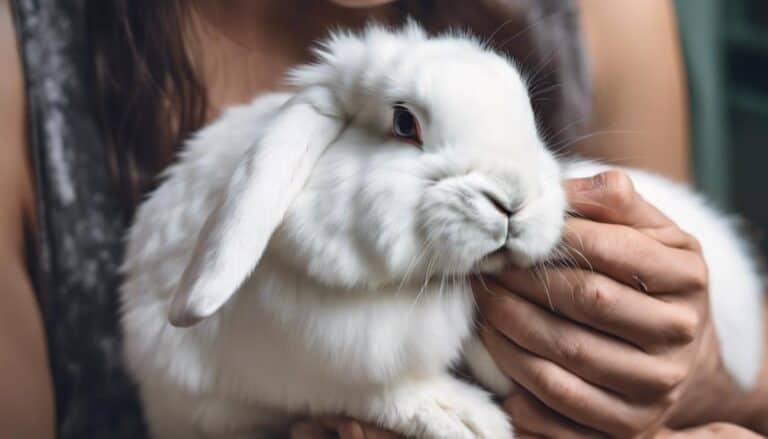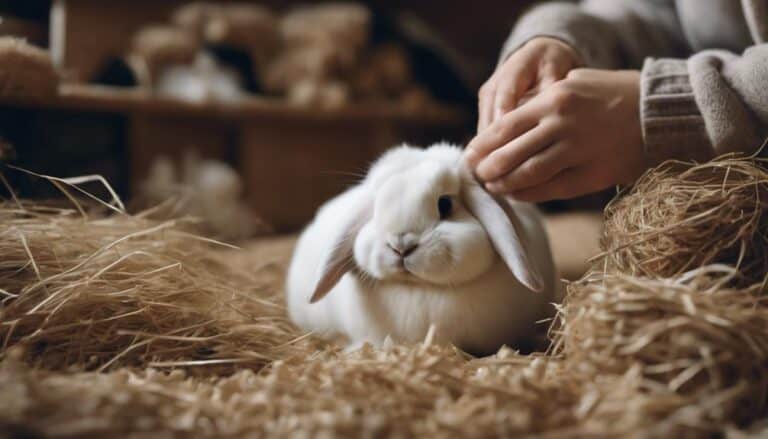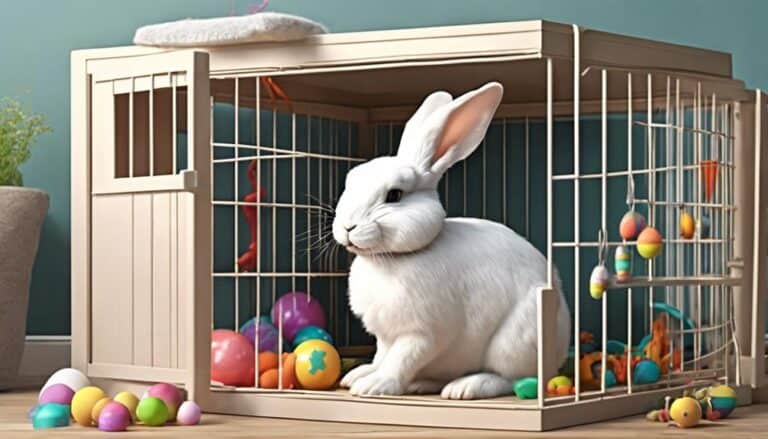Female rabbits can have babies every 14 to 16 days. Their pregnancies only last about 30 days. They can have lots of baby bunnies in a year and start being able to have babies when they're between 3 and 6 months old.
It's really important to give them a break of at least 60 days between having babies to keep them healthy. It's good for rabbit owners and breeders to know all about how rabbits breed and when they can have babies.
Contents
- 1 Key Takeaways
- 2 Reproductive Cycle of Rabbits
- 3 Frequency of Bunny Breeding
- 4 Rabbit Breeding Patterns
- 5 Breeding Rate of Bunnies
- 6 Reproduction Frequency in Rabbits
- 7 Bunny Mating Behavior
- 8 Gestation Period of Rabbits
- 9 Factors Affecting Bunny Breeding
- 10 Bunny Fertility and Reproduction
- 11 Controlling Bunny Population
- 12 Frequently Asked Questions
- 13 Conclusion
Key Takeaways
Female rabbits can have babies every 14-16 days. They can have up to 5 litters in a season. It's a good idea to wait 60 days between each time they have babies. Wild rabbits are able to have babies for about 243 days in a year. It's really important to be responsible when breeding rabbits to make sure they stay healthy and happy.
Reproductive Cycle of Rabbits
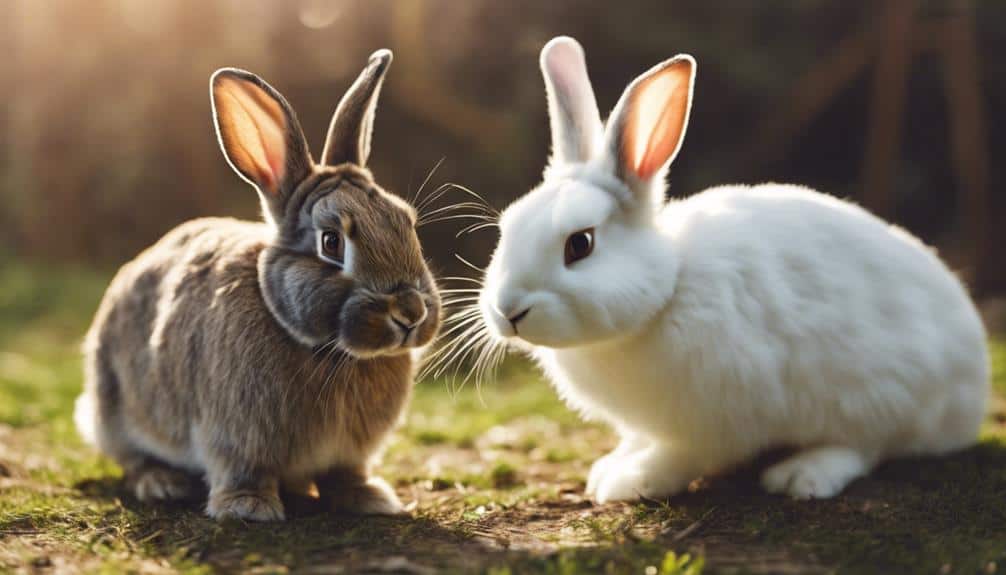
Rabbits have a pretty interesting way of making babies. Female rabbits can get pregnant every 14 to 16 days, which is quite often compared to other animals. This means they've a lot of chances to have babies. When a female rabbit gets pregnant, she carries the babies for about 31 to 33 days before giving birth to a group of baby rabbits called kits. What's really cool about rabbits is that they can have multiple litters in a single year. Some female rabbits can have anywhere from 1 to 7 litters in a year, showing how good they're at having babies.
Female rabbits are built for quick and efficient baby-making. They can get pregnant again soon after giving birth, keeping the cycle of making babies going strong. Knowing how often rabbits can have babies is important for people who take care of them or breed them, as it helps them understand how many litters a rabbit can have in a year.
Frequency of Bunny Breeding
Female rabbits can get pregnant every 14-16 days, which means they have a lot of chances to have babies.
When we talk about how often bunnies breed, we need to think about how long the breeding season lasts, when rabbits are old enough to have babies, and how much time passes between each birth.
Knowing these things can help us make sure rabbit populations stay in check and that they stay healthy when they have babies.
Breeding Season Length
Rabbits are pretty amazing when it comes to making baby bunnies. They can have babies pretty much all year round, with their breeding season lasting about 243 days each year. This long breeding season lets rabbits have lots of babies throughout the year. Wild bunnies usually follow this schedule based on the environment around them.
Pet rabbits, on the other hand, can have babies at any time because they live in controlled conditions with plenty of food. Female rabbits only carry their babies for about 31 days before giving birth. Another cool thing about rabbits is that they release eggs right after mating, which helps them have even more babies. This constant ability to have babies, along with being able to get pregnant again right after giving birth, shows just how good rabbits are at making more rabbits.
Reproductive Maturity Age
When thinking about how often bunnies have babies, it's important to know when rabbits are ready to reproduce. Rabbits usually become mature enough to breed between 3 and 6 months old, depending on their breed. Smaller rabbits can start breeding as early as 3 months, while larger breeds mightn't be ready until they're 5 to 6 months old. This difference in maturity age affects how often rabbits can have babies.
Female rabbits, or does, can get pregnant right after giving birth. This means they can have frequent breeding cycles if the conditions are right. Responsible breeding practices rely on knowing when rabbits can start breeding, which helps keep both the rabbits and their babies healthy and well.
Interbirth Interval Period
Rabbits have a unique reproductive cycle where they can have babies every month. Female rabbits can get pregnant again just after giving birth, which means they can have a new litter every 30 days. This quick turnaround in breeding is special to rabbits because they can conceive shortly after having babies. This short break between litters means there can be a lot of baby rabbits born in a short time.
It's really important to keep an eye on how often female rabbits are having babies to make sure they don't have too many litters. Responsible breeding is key to looking after the welfare of the rabbits. By understanding and managing the time between births, we can make sure our breeding program is healthy and sustainable.
Rabbit Breeding Patterns
Rabbits breed a lot because female rabbits can get pregnant again right after giving birth. A pair of rabbits can have many babies in a year since their pregnancy only lasts about 30 days. This short time frame allows them to have babies frequently.
Female rabbits are really fertile and can have up to 12 babies at once, which helps them reproduce quickly. Wild rabbits, in particular, can breed for about 243 days a year, giving them lots of chances to have babies. It's important to wait at least 60 days between breedings to keep the rabbits healthy.
Knowing these breeding patterns is crucial for managing rabbit populations and making sure breeding is done responsibly.
Breeding Rate of Bunnies

Female bunnies can have a lot of babies because they can get pregnant quickly and easily. They've babies often because they can have many litters. A female rabbit only stays pregnant for about 30 days, so she can get pregnant again soon after giving birth. In good conditions, a mom bunny can have babies once a month.
Wild rabbits can have babies for about 243 days each year, so they can have many litters. But male rabbits, called bucks, mightn't be able to make babies when it's really hot, which can slow down how many babies they have. Knowing how fast bunnies can have babies is really important for people who take care of them or breed them. Understanding their ability to have babies helps make sure the bunnies and their babies stay healthy and happy.
Reproduction Frequency in Rabbits
Female rabbits can get pregnant again right after giving birth because they have a quick reproductive cycle. This means a doe can be expecting another litter soon after delivering one. Some rabbits can have up to 5 litters in a season, depending on the breed. The House Rabbit Society recommends waiting at least 60 days between breedings to ensure the rabbits' well-being. Wild rabbits, on the other hand, are usually fertile for about 243 days every year, which makes them very good at reproducing.
It's important to think about how the environment can affect how often rabbits breed. For example, male rabbits may become temporarily infertile in high temperatures, which can impact how many baby rabbits are born overall. By understanding how rabbits reproduce and practicing responsible breeding, we can help keep these animals healthy and happy.
Bunny Mating Behavior
Bunnies are quite the social butterflies when it comes to mating! Female rabbits can have anywhere from 1 to 7 litters in a single year because of their promiscuous mating behavior. This means they've lots of chances to get busy with the bucks.
When a female rabbit mates, it triggers the release of eggs, making it easier for her to have frequent mating opportunities. However, bucks can hit a roadblock in hot weather, experiencing temporary sterility which can affect how often they can mate.
Wild rabbits are on a bit of a schedule, being fertile for about 243 days each year. This plays a big role in how often they breed and reproduce.
Understanding how bunnies get together for baby-making is super important for managing their breeding and keeping their population in check. By knowing the ins and outs of their mating habits, we can make sure bunnies stay happy and healthy.
Gestation Period of Rabbits
Rabbits have different gestation periods, which usually last between 31 to 33 days. Some rabbit breeds may have slight variations from this timeframe. When rabbits mate successfully, the birth of their kits typically happens within this 31 to 33 day window.
It's important to know that certain commercial rabbit breeds can have much shorter gestation periods. In some cases, their pregnancies may only last around 24 days. Conversely, if a doe is carrying a smaller litter, the gestation period might be longer.
The length of gestation can also differ depending on the rabbit breed. For example, English lops usually have an average gestation period of 29 to 31 days. On the other hand, Netherland dwarfs typically range from 30 to 31 days.
Understanding how long rabbits are pregnant for is crucial for breeders. This knowledge helps them prepare for the arrival of new litters and ensures they can provide proper care and management during this important period of growth and development.
Factors Affecting Bunny Breeding
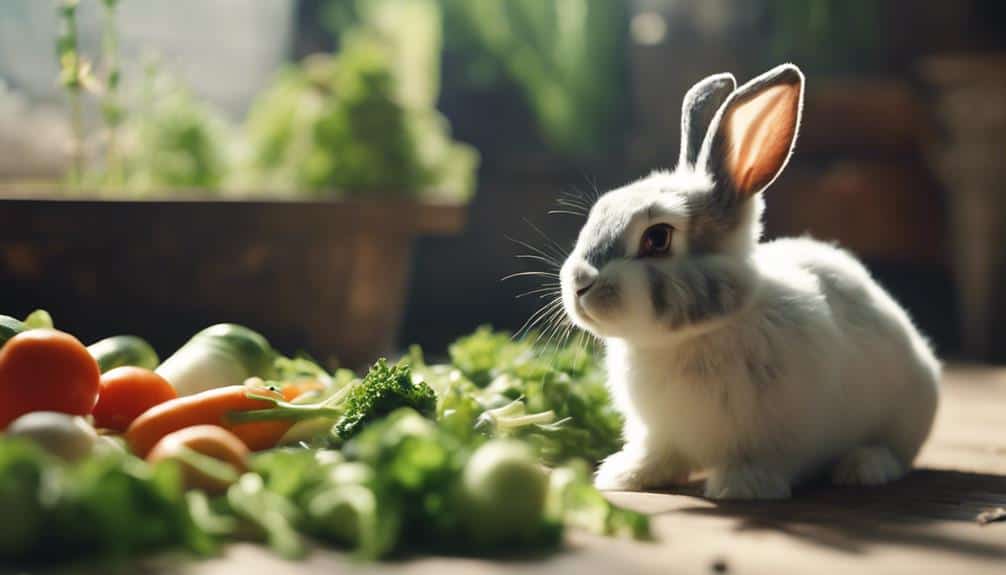
Breeding in bunnies happens quite frequently due to a few important reasons. First off, rabbits have short pregnancies that last only about 30 days, making it easy for them to have quick pregnancies one after the other. Plus, female rabbits can get pregnant right after giving birth, so they can have babies in rapid succession.
Another thing that affects how often rabbits breed is the size of their litters. Some rabbit breeds can have a lot of babies in one go, with some having as many as 12 kits at a time. This can influence how frequently rabbits reproduce.
It's crucial to consider the health and well-being of the rabbits when it comes to breeding. Overbreeding can lead to problems for both the mother rabbit and her babies, underscoring the importance of responsible breeding practices to ensure the welfare of the rabbits.
Bunny Fertility and Reproduction
Breeding in bunnies happens often because female rabbits are ready to mate for most of their reproductive cycle. When rabbits mate, the female's ovulation is triggered by the act itself. This means they're ready to mate about 14 days out of every 16. A vet can spot fetuses in a pregnant doe's belly as early as 12 days after mating, which helps in detecting pregnancy early on.
Rabbits usually carry their babies for about 31 to 33 days, but if a doe has a small litter, it might take a bit longer. To get ready for birth, it's a good idea to introduce nest boxes around 28 to 29 days after mating. These boxes provide a cozy spot for the pregnant doe to give birth. It's crucial to keep an eye on the birthing process because if labor doesn't start by day 34, there's a chance of stillborn kits being delivered. Knowing these details about bunny breeding is important for the well-being of the does and their babies.
Controlling Bunny Population
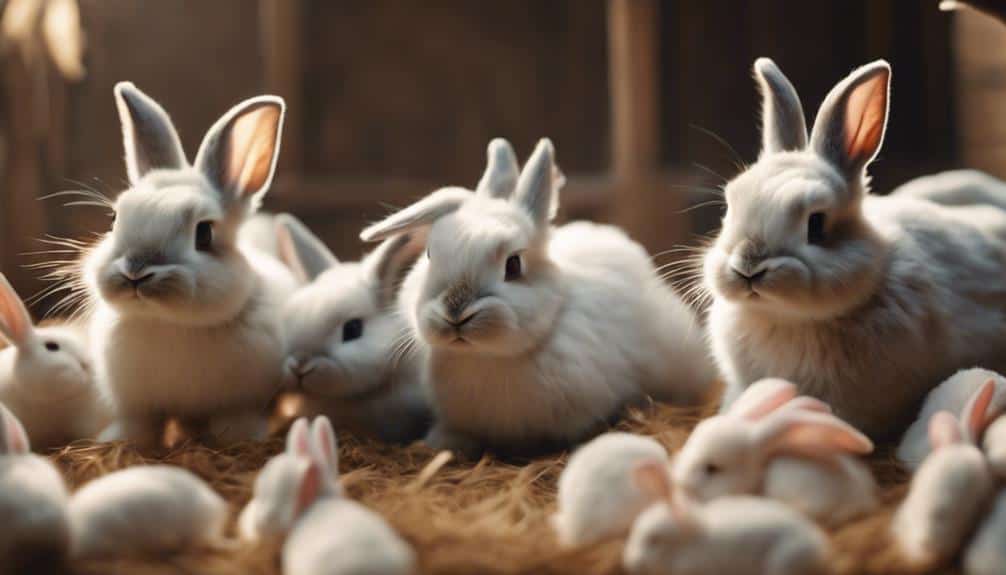
To keep the bunny population in check, you should spay and neuter your rabbits to stop them from having babies when you don't want them to.
You can also set rules on breeding to control how many baby bunnies are born.
Encourage people to adopt rabbits from shelters and rescue groups instead of buying them, which can help lower the need for breeding and keep the bunny population under control.
Spaying and Neutering
When you spay or neuter your rabbit, you're helping control the bunny population and being a responsible pet owner. Here are some important things to keep in mind:
Spaying or neutering your rabbit stops them from having lots of babies, which can lead to too many bunnies around.
It's a way to show that you care for your pet and want to make sure they've a good life.
By spaying or neutering rabbits, shelters can focus on finding homes for bunnies already in need, instead of dealing with more and more rabbits being born.
These procedures help rabbits stay healthy and happy by preventing unnecessary suffering and avoiding the need for putting them down.
Breeding Restrictions
Responsible rabbit breeders usually suggest waiting at least 60 days between breeding sessions to give the rabbits enough time to fully recover. This break is crucial for the mother rabbit to regain her strength and nutrient levels before possibly getting pregnant again. Good breeders also advise against having more than 3 litters in a year to ensure the rabbits' health and well-being.
Overbreeding can lead to issues like less healthy litters and an increased risk of overcrowding, stress, and aggression among the rabbits.
To tackle these concerns, spaying, neutering, and keeping male and female rabbits separate are vital steps to manage breeding and prevent overpopulation problems. By following these breeding guidelines, breeders can prioritize the welfare of their rabbits and uphold a sustainable breeding practice.
Adoption Promotion
If we want to keep the bunny population in check and make sure rabbits have good homes, we need to focus on adoption campaigns. These campaigns encourage people to give sheltered rabbits loving homes. By promoting adoptions, we can help manage the rabbit population and avoid overpopulation issues.
Here are some important things to think about:
- Getting rabbits spayed or neutered is key to controlling overpopulation and preventing unwanted bunnies from suffering.
- Being a responsible rabbit owner can help reduce unplanned breeding.
- Teaching people about the importance of spaying/neutering and responsible breeding is crucial for keeping the rabbit population healthy.
- Encouraging adoption and fostering of rabbits can ease the burden on shelters and ensure these animals have happy lives.
Frequently Asked Questions
How Many Times Do Rabbits Mate a Year?
Rabbits can mate quite often, you know. They're able to do it multiple times throughout the year. Female rabbits can get pregnant frequently, which means they could have several litters in a single year.
How Quickly Do Rabbits Breed?
Bunnies breed pretty fast because of their genes. But, things like the environment can also affect how often they breed. Female bunnies can get pregnant right after giving birth, which means they can have a lot of babies in a short time. That's why it's really important to spay or neuter them.
How Often Should You Breed Rabbits?
When it comes to breeding rabbits, you need to think about how often they have babies. It's really important to give the rabbits enough time between pregnancies so they stay healthy. Keeping it to 3 litters a year is a good way to make sure they're well taken care of.
Do Rabbits Really Breed That Quickly?
Rabbits have a lot of babies really quickly, they can have multiple litters in a year. This can cause problems because there can be too many rabbits in one area. To help keep the rabbit population in check and protect the environment, it's important to spay and neuter them. This helps prevent them from having more babies and overwhelming the ecosystem.
Conclusion
Bunnies breed a lot because of how often they reproduce and their mating habits. They've a high breeding rate and a short pregnancy period, which helps them multiply quickly. Things like age, health, and the environment can affect how well bunnies can have babies.
To keep bunny populations in check, it's important to understand and control their breeding habits. You know the saying, 'breeding like rabbits'? Well, it's true that these fluffy creatures are really good at making more bunnies.

